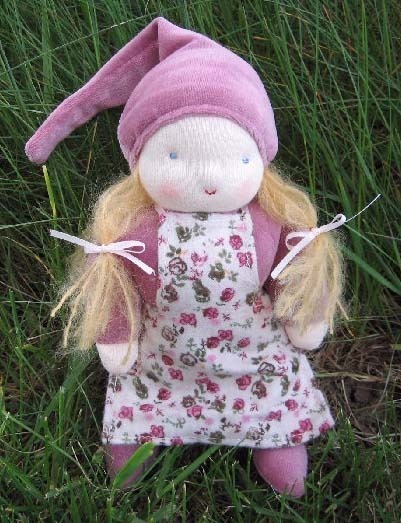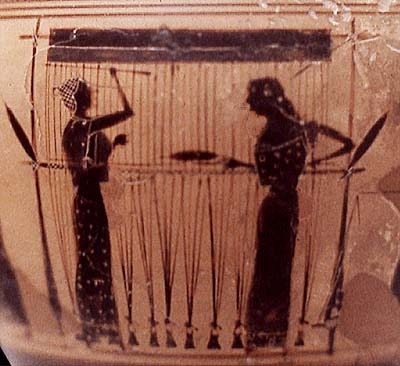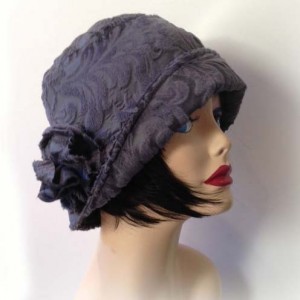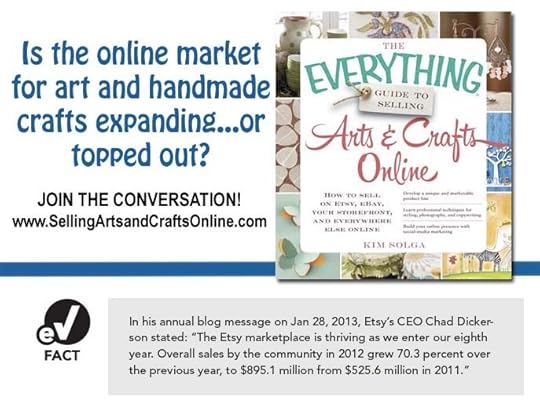Kim Solga's Blog, page 2
April 30, 2014
Socialize with Pinterest
Since buying and selling arts and crafts is a visual business, it makes sense that Pinterest, the most visual of social networking sites, is an important resource for you to explore.
Pinterest.com is designed for collecting and sharing pictures of things you love. Pinterest users set up bulletin boards with different topics. Then they “pin” pictures from the Internet onto these boards, usually writing a short comment about each image. Boards are shared with friends and usually available set to be public and available to the whole Pinterest community…(that would be 10 million users in 2013). People follow other people’s boards when they find them interesting, click “like” when a pin strikes their fancy, make comments, and re-pin other people’s images. The result is a vibrant visual community of ideas and images – and links, since each image pinned is a link back to the website where the photo originated.
 Artists and crafters will quickly discover the power of Pinterest for sharing photos of their work. And as with all good social media campaigns, it’s all about collaboration and content. Sign up for a free account and dive in. You won’t get very far if you only pin your own work, though. Mix it up – your own pieces should be a tiny percentage of what you put on your boards. Pin great items you see on Etsy, on artist websites, in blogs and elsewhere on Pinterest. Others will do the same for you!
Artists and crafters will quickly discover the power of Pinterest for sharing photos of their work. And as with all good social media campaigns, it’s all about collaboration and content. Sign up for a free account and dive in. You won’t get very far if you only pin your own work, though. Mix it up – your own pieces should be a tiny percentage of what you put on your boards. Pin great items you see on Etsy, on artist websites, in blogs and elsewhere on Pinterest. Others will do the same for you!
The illustration for this article is a polymer clay treasure I pinned a couple years ago…a teapot by Alyssa from ClaydeLys (one of the artists featured in Selling Arts and Crafts Online). This pin has gotten more likes and shares over the years than anything else I’ve posted on Pinterest…15 “likes” and a whopping 46 “Repins,” so far. Thousands of people have seen and shared Alyssa’s amazing work, clicked the teapot and visited her Etsy shop.
More about using Pinterest to promote your own arts and crafts business in The Everything Guide to Selling Arts and Crafts Online… pick up a copy and kick-start your success.
Once you’re on Pinterest, be sure to follow the board for Selling Arts and Crafts Online.
April 27, 2014
Keeping Track
One challenge for serious sellers is managing inventory. This is made more complicated when you are dealing with inventory that appears in many places and is constantly going in and out of stock. You may have the same items posted in your Etsy shop, on your own website, displayed at craft fairs, on display in a local gallery or giftshop, and sold directly to friends and neighbors.
Keeping track with pencil and paper is a good start, and works for awhile with a beginning product line and a few sales outlets. Discovering an automated system is your next major step in taking your business seriously.
You can use a spreadsheet application like Microsoft Excel to set up inventory tracking on your computer, especially if you have experience using business applications. A good online spreadsheet program is free to use on Google Drive. There are plenty of computer programs you can buy to track inventory, from POS (Point of Sale) systems for stores to inventory management systems for manufacturers. Some are designed specifically for different types of artists and crafters.
But the latest inventory management tools are “in the cloud” – online systems available for a monthly fee. There are several specifically targeted to the art and crafts market. You can track your products at different stores and selling locations, whether Internet based or physical stores and galleries, consignment or wholesale. You can track individual customers themselves, complete with integrated email lists.
 StitchLabs inventory and order management system is very popular among serious Etsy sellers, integrating seamlessly with an Etsy shop. StitchLabs was developed as an API app for Etsy shops, but goes far beyond. You can connect to many other online selling platforms, from eBay to Shopify. There are modules to connect to PayPal payment gateway and to QuickBooks for accounting. It is a management system with a huge potential for artists and crafters.
StitchLabs inventory and order management system is very popular among serious Etsy sellers, integrating seamlessly with an Etsy shop. StitchLabs was developed as an API app for Etsy shops, but goes far beyond. You can connect to many other online selling platforms, from eBay to Shopify. There are modules to connect to PayPal payment gateway and to QuickBooks for accounting. It is a management system with a huge potential for artists and crafters.
Craftybase is another online system made for professional crafters that allows you to track products, sales and much more. It does an especially good job of tracking the creative process – the raw materials and the time that goes into making your items.
Bizelo is designed for general online sellers but with a new focus on Etsy and the arts marketplace.
And the Run|Inventory system, while simpler, is free.
So start inventory tracking from the very first days of selling your artwork, and explore the computer options for making this task a whole lot easier and more informative as your business grows.
Links and ideas (and lots more in the book) from Chapter 4 of Selling Arts and Crafts Online. You’ll absolutely love this book!
March 30, 2014
Elf Dolls and Pricing
One of the toughest things is to find the right price to charge for your artwork…If prices are too high, sales will drop…or simply not even begin. If prices are too low, you’ll find yourself unable to continue making new items. The sweet spot between these extremes, the price that is just right for your wonderful products, is not that hard to discover.
Chapter 14 in Selling Arts and Crafts Online is all about pricing, and gives you the power of a simple formula to help you succeed!
The formula. It’s been around for decades and has been the backbone of many successful businesses. It goes like this:
Materials + Labor + Overhead + Profit = Wholesale price.
Wholesale X2 = Retail price.
 The first element, Materials, is everything that goes into your product. If you are sewing elf dolls, like this fabulous example from LittleElfsToyshop, it’s the cost of fabric, stuffing, buttons, ribbon and yarn. Remember to include little things like the cost of thread. Figure this cost of a batch – buying everything you’ll need to produce 10 items for example – then dividing by 10 to get your cost per item.
The first element, Materials, is everything that goes into your product. If you are sewing elf dolls, like this fabulous example from LittleElfsToyshop, it’s the cost of fabric, stuffing, buttons, ribbon and yarn. Remember to include little things like the cost of thread. Figure this cost of a batch – buying everything you’ll need to produce 10 items for example – then dividing by 10 to get your cost per item.
The next element, Labor, is the time it takes you to make and ship the item, and how much is this time worth per hour. Be sure to calculate this at a fair wage. You don’t want to base your business on “sweatshop” wages, whether for yourself or anyone else. Likewise, if you value your time too highly, you will soon price yourself out of the market. Be fair but don’t be greedy.
Overhead: Add up everything it costs for you to be in business for a month…then divide by the number of items you plan to sell each month. What do you spend on your business that you would not otherwise need to pay for? These costs are things such as
office supplies and packing tape to seal shipping boxes
the cost of your business bank account if you opened one
rent for studio space
the fee your tax person charges
long term costs should also be factored into this…a new computer every few years, repair on the sewing machine
….and so on
At the beginning there will be expenses you do not include. If you are working out of your home, in a spare bedroom perhaps, you might choose to ignore expenses like rent, electricity and heat. After all, you’re living there and would need to pay rent and utilities anyway. But remember that such costs are a legitimate part of doing business. As you grow, you may want to add these costs in anticipation of the day you will need to rent larger studio and office space.
The number of items you will sell should be an honest guess if you are just starting out. After a few months of sales, you will be able to track and project the real number. So overhead total divided by number of sales = the per item amount.
The last element in the formula is Profit. This is the value you put on your investment of energy, your creative spark, your unique talent, and the money you’d like to make to expand your business. Accounting for profit right from the beginning will give you a wholesale price you can live with. Some people double the manufacturing price to get their profit – saying that “materials + labor + overhead X2 = profit”. Other folks add much more, while yet others set their profit far lower. The profit figure is yours to set and to change as time goes by. Only you can decide what it should be.
Back to elf dolls then…let’s say you carefully track what it takes to make dolls.
Materials: You buy enough cloth, yarn, stuffing and buttons to make 10 dolls. The bill is $30 at the fabric store, so that gives you a materials price of $3.00 per doll.
Labor: After carefully logging in the time you spend, you discover that it takes you 5 hours to sew 10 dolls start to finish, another 2 hours to photo them all and add them to your Etsy shop, and finally about 18 minutes to package and mail a doll order (another 3 hours of your time if you sell 10 of them). This all comes to 10 hours per 10 dolls, or an hour each. If you figure a fair wage is $12 per hour, the labor for each doll comes to $12.00.
Overhead: After figuring all of your costs for Etsy fees, Paypal fees, the packing materials, office supplies, sewing supplies, and every other business detail, you come up with a monthly overhead cost of $40.00. You’re working at home, so right now you are not including rent or utilities into overhead. You also have a computer and Internet access for personal use, so you are not going to count that cost either. You average 10 doll sales per month. So $40 divided by 10 sales means each doll sale needs to cover $4.00 of overhead.
Profit: You decide to add $5.00 per doll for business expansion and because your dolls are so unique and awesome!
$3 + $12 + $4 + $5 = $24 is your wholesale price. Double that to get retail, so you sell your dolls on Etsy for $48.
More on how to tweak the pricing formula and make it work for you in Chapter 14. You’ll absolutely love this book!
_____
Illustration “Hazel the Girl Gnome” courtesy of and © LittleElfsToyshop on Etsy.
February 12, 2014
Share your expertise
 This morning there was an email from Etsy inviting sellers to “Tell Us Your Story.” The request was from Etsy’s Seller Handbook team. A handy online form is linked so Etsy sellers can pitch the story they wish to share – either to write it themselves or to be interviewed by a regular editor. In the words of writer Katie Noonan…
This morning there was an email from Etsy inviting sellers to “Tell Us Your Story.” The request was from Etsy’s Seller Handbook team. A handy online form is linked so Etsy sellers can pitch the story they wish to share – either to write it themselves or to be interviewed by a regular editor. In the words of writer Katie Noonan…
“When you tell the story behind your shop, you give it added value and credibility. Shining a spotlight on your inspiration, materials and process can help attract new buyers and create a loyal following among current ones. Interesting details can also catch the eye of editorials teams, including Etsy’s own Seller Handbook editors, who scour the marketplace regularly for story ideas and sources. With that in mind, take a few minutes to fill out our Pitch Form. ”
So I did just that, offering the subject of how my own experiences as a seller on Etsy (via my BlueOtterArt shop) informed and inspired The Everything Guide to Selling Arts and Crafts Online. I hope they take me up on the proposal, and give me the chance to share the amazing collaborations that are included in this book and found on this website.
I challenge you to do the same. If you have a story to share about your own Etsy experience, submit a Pitch Form yourself. Share your expertise with your community. It makes us all stronger!
And explore Etsy’s Seller Handbook Archives. It’s filled with stories that will inform and inspire your work.
February 4, 2014
Inspiration from Maya Penn
Here’s a spot of inspiration – a “Ted Talk” from Maya Penn, a delightful young woman who, at age 13, already knows a bit about selling arts and crafts online.
There’s nothing that makes me more optimistic than kids and Ted Talks!
Check out Maya’s website at mayasideasshop.blogspot.com
January 20, 2014
Authentic Arts from Jenny Hoople
 The Everything Guide to Selling Arts and Crafts Online is filled with real stories – artists and artisans who are successful sellers on the Internet. Their stories will inspire and their advice will guide your own steps to success. Jenny Hoople, the owner and creative genius of Authentic Arts at JennyHoople.com, shares her experience in building and managing your own website. Read her Words of Wisdom in Chapter 11!
The Everything Guide to Selling Arts and Crafts Online is filled with real stories – artists and artisans who are successful sellers on the Internet. Their stories will inspire and their advice will guide your own steps to success. Jenny Hoople, the owner and creative genius of Authentic Arts at JennyHoople.com, shares her experience in building and managing your own website. Read her Words of Wisdom in Chapter 11!
[image error]
“Myself/my biz/my advice are in a book feeling so super famous right now!” Jenny writes on the Authentic Arts Facebook page www.facebook.com/authenticarts
Jenny calls herself a geology nerd, and indeed her website, blog and Pinterest boards share a fascinating display of mineral beauty.
Her business sense has narrowed this field down to a charming and popular niche. Jenny creates jewelry from naturally smoothed and rounded river stones… lake stones… sea stones. These are the sweet little pebbles you pick up on a beach walk. Hold in your hand, carry in your pocket for awhile. We love to take them home as souvenirs, line the stones along a sunny windowsill, or display in a clear vase or basket.
Jenny kicks it to the next level. With perfectly proportioned holes drilled in each stone, she matches the subtle colors and textures to create amazing jewelry. Check out her wonderful River Rock Jewelry for a great example of developing a popular and successful product line from the wide field of your interests. Gratitude to Jenny for sharing her expertise, and welcome to new baby Brian!
December 28, 2013
Making the honor roll
 I’ve written a few books in my diverse career. Each one has been a labor of love, with the emphasis on the “labor” part at the beginning. Writing a book is a piece of work! But once a book is published, it is like a pesky teenager who has finally headed off to college, off into the world to make a life. You pat them on the head and hope for the best.
I’ve written a few books in my diverse career. Each one has been a labor of love, with the emphasis on the “labor” part at the beginning. Writing a book is a piece of work! But once a book is published, it is like a pesky teenager who has finally headed off to college, off into the world to make a life. You pat them on the head and hope for the best.
So imagine my delight to walk into Bookshop Santa Cruz, one of the SF Bay area’s leading independent book stores, to see Selling Arts and Crafts Online on the display shelf for “Best Nonfiction of the Year.” A lovely surprise from my favorite bookseller. It is thrilling enough to spot Selling Arts and Crafts Online back in the How-To section, among the craft books and business guides. But front and center as a Best Pick! Awesome!
I hope your creations – your artworks made with skill and beauty – bring you a similar thrill when you come upon them honored and displayed by your customers, followers and fans!
November 12, 2013
Etsy Re-defines Handmade
Etsy, THE online resource for all things vintage and handmade, recently expanded their basic policy on what is allowed be called a “handmade” item. According to an editorial in today’s New York Times, “…last month, Etsy announced new policies that would allow sellers to apply to peddle items they produced with manufacturing partners, as well as to hire staff and use outside companies to ship their goods.”
 Many Etsy sellers have voiced outrage at what they see as a betrayal of a commitment to handcrafted art and crafts. How are authentic artisans going to be able to compete with resellers offering lower cost manufactured “handmade items?”
Many Etsy sellers have voiced outrage at what they see as a betrayal of a commitment to handcrafted art and crafts. How are authentic artisans going to be able to compete with resellers offering lower cost manufactured “handmade items?”
But Etsy is expansive:
Etsy sellers can hire whatever number of people they need to product items they have designed, and these employees can work in other locations.
Sellers can use shipping and fulfillment services.
It’s okay to work w/ outside partner and manufacturers if approved by Etsy.
And if a seller hires people and uses outside partners, this must be disclose on your shop’s about page (though not necessarily in the item description).
The Times article, Etsy’s Industrial Revolution by Elizabeth Wayland Barber, a professor of archaeology and linguistics, explores the definition of handmade from a historical perspective, “a history that is more complicated than the simple term ‘handmade’ implies. The artisans have run head-on into the problem that led to the Industrial Revolution: Making things by hand is slow. Really slow.”
Is a scarf truly handmade if it is created with machine-produced yarn? Does the knitter also have to spin her own wool? What about those spinning wheel machines and looms? And how does this all relate to ancient Assyrian textiles?
Enjoy the glimpse into an issue that has spanned the centuries, and post your opinion in the comment box!
October 31, 2013
Vintage Hats and Market Need
Who are your customers? What do they need? How are you giving them what they want?
“Market Need” is one of the elements of a business plan. New business owners often put off writing a business plan for months – years even. They imagine that it’s only needed if they seek a bank loan or formally present to investors. But a business plan is important to your arts success right from the beginning.
 The Etsy Blog is a great source of business information for starting an online business, whether or not you choose to have a shop on Etsy. A recent post was titled “How to Write a Creative Business Plan In Under an Hour.” Blog author Caroline Cummings breaks down the standard parts of a formal business plan into short statements. She demonstrates the process with a fictitious Etsy store she calls Haley’s Vintage Hats.
The Etsy Blog is a great source of business information for starting an online business, whether or not you choose to have a shop on Etsy. A recent post was titled “How to Write a Creative Business Plan In Under an Hour.” Blog author Caroline Cummings breaks down the standard parts of a formal business plan into short statements. She demonstrates the process with a fictitious Etsy store she calls Haley’s Vintage Hats.
The “Market Need” for Haleys? “My customers love the look of vintage women’s hats, but real vintage hats are difficult to find and very expensive if in excellent condition, while good replica hats are not common.” A short, simple statement.
And Haley’s solution? “I recreate hats from my collection of authentic designer vintage hats of the 1920s-60s and sell these affordably so my customers can own and wear hats in the style of their favorite vintage milliners.” Again, how clear is this? Cummings’ fictitious business owner easily defines her target audience (women who love and want to wear vintage designer fashions) and can fill their needs with handcrafted replica hats.
Why do your customers need the items you sell? What makes them like your work and place an order?
In “The Everything Guide to Selling Arts and Crafts Online” you’ll fine a simple common-sense chapter to help new business owners create a business plan. with sections including:
Parts of a Business Plan
Keep a Journal
Product Line (yes, you will begin to think of your creative work as a product!)
Your Twelve Monthly Landmarks
If you have not yet written a business plan for your new arts business, do it today. What a powerful tool for your success!
—–
Even better than the fictitious Haley, our illustration is from a REAL vintage hat designer on Etsy! Illustration courtesy and ©Kimberley at TheWaughdrobe on Etsy: etsy.com/shop/TheWaughdrobe
September 19, 2013
Is there still room to start selling online?
The Internet has revolutionized the sale of handcrafted artwork. No longer are crafters and artists limited by geography to selling their work in regional shops and galleries, fairs and bazaars. With the development of online shopping and marketplace websites, artists can develop an international clientele.
The wide variety of arts and crafts available online reflects the diversity of this worldwide market. There truly is room for every seller and every artistic tradition, from traditional to contemporary, Victorian to primitive, elegant to shabby chic. It is not too late to get started – in fact, there has never been a better economic and technological environment to build your own success as an online merchant. The Everything Guide to Selling Arts and Crafts Online is a great first step, with detailed, common-sense advice and instructions.





